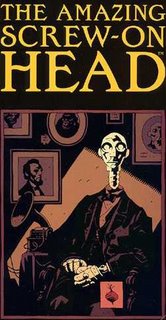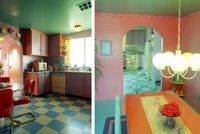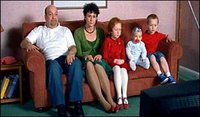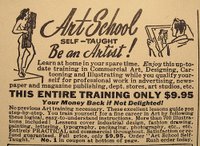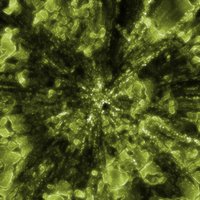▼
July 30, 2006
July 29, 2006
July 28, 2006
July 27, 2006
July 26, 2006
Basement Beasties
Three years ago Rachel and I had the spontaneous idea of doing a Michel Gagne style children's book. Like many self-motivated little side-projects it never got complete. Tasks like adjusting all the page layouts, making backgrounds, and adding textures to all the creatures never got done. Once the down-time in the studio was over it was put on the back burner, we got very busy with other projects and it was never thought of again. Ben Jeddrie supplied the wonderful writing, Rachel Morrison did all the beastly sketches, and I provided the book cover and creature colors. I've recently uncovered these while going through old back-up CDs, here's some samples.

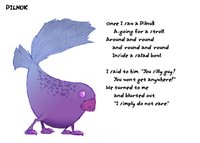

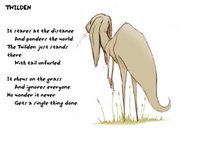
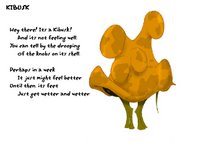

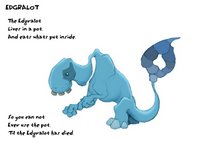

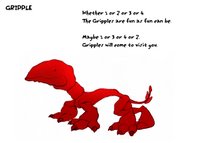
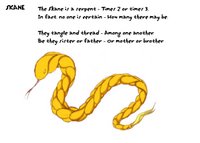
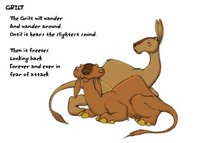











July 23, 2006
The Amazing Screw-On Head
Head over to Sci-Fi's site and check out the pilot episode for Mike Mignola's The Amazing Screw-On Head animated series. Beautifully animated and looks as if each frame was drawn by Mignola himself.
You Tube Gold!
July 07, 2006
Work On You

Here it is! The MSTRKRFT music video!
Finally online for all to see!
It took 10 weeks to produce from concept to completion!
100% Flash! We had a blast working on it,
hope you enjoy it.
The hi-res version: 640 The lo-res version: 320
Also recently featured on Cold Hard Flash.
Now broadcasted here on: Much Music
both online and on television!
Director: Mike White
Co-Director: Derek Jessome
Designs: Derek Jessome, Jeff Knott, Chad Boutilier
Storyboards/Layouts: Derek Jessome, Jeff Knott, Mike White
Backgrounds: David Sourwine
Story: JFK/ALP
Creative Consultant/FX Supervisor: Ron Doucet
Animators: Jacques Daigle, Adam Gunn, Rachel Morrison,
Bianca Siercke, Dave Thomson
Clean-Up Artists: Chad Boutilier, Ian Gallant, Andre Morrison,
Ranada Nickerson, Marc Robichaud
FX Animators: Jake Macher, Sean Garnier
Post Production: Jacques Daigle, Peter Giffen
Documentary By: Cory Laffin
July 06, 2006
July 05, 2006
July 04, 2006
ToonBoom vs. Flash
There's been a lot of buzz lately over "The Miracle of ToonBoom", and how Canadian and European Animation or I&P based studios are converting to this wonderful piece of software. I just thought I'd take the time to warn the public about this software before any 2D animation production company makes the mistake and switches over to this system.
I took a full two-day training seminar in ToonBoom Solo last September. I went in with an open mind, trying desperately to think about the long term effects of such a new system, the ramp up learning time for traditionally-trained animators, the practical and technical advantages and disadvantages to our approach to creating animated series, and the overall effeciency rating and how it would improve production flow (long term) in our studio environment.
I'll admit, I was skeptical at the very beginning, it was very overwhelming, the interface was far less inviting and simple then when I first began to use Flash 3 back in college. Again I tried to ground myself, and did my best to not compare with Flash all the time, but it was difficult, I couldn't help but imagine the Flash comparisons for every function, tool, and process presented to us. Every simple step was far more labour intensive then Flash. But I kept waiting for the big "effeciency advantage phase", the big miraculous "animates a whole show for you i 6 seconds" type of thing that it advertises. But it never came. Very very very lengthy proceedures for just making a few drawings and "symbols", everytime I needed to draw two poses and wanted an "onion-skin" it to do some inbetweens it was a long and arduous proceedure for the simplest task. By the end of a 9 hour session I had a bit of a headache, the "salesmen" was VERY knowledgable of the program, and he took leaps and bounds to show us all the advatages it had over Flash.
After a long day of him showing us all the functions, commands, and tools and not really getting anywheres, I was ready for him to really show us samples of ToonBom at its best, in the hands of awesomely talented animators... what could it do? what was it's full potential?!?! All he had for us was a nice little short of a 6Teen demo. Well you can imagine my surprise, it was VERY stiff, very limited in movement, it was my first time seeing the show and I thought to myself "It looks just like Flash!". So it looked like symbol-sliding style animation and I was confused, a few months later I saw a 2min. demo for a show Mercury did, it was beautifully designed and animated and I found it was ToonBoom created, then I found out how much that 2min. demo cost and how much they estimated every 22min. episode would cost in the same squashy-stetchy style of nearly-full-animation, and I was blown away!... It was a lot more than any standard classically-animated series for Canadian or U.S. broadcast (usually animated all over-seas). So though the quality was great and the studio had done a fabulous job in designs, animation, timing and colors, it didn't live up to the hype about ToonBoom's advantages in cutting costs in production with speed-of-light techniques. 6Teen like many other Flash shows have stunning art direction, ToonBoom and Flash allows for very sharp and consistent designs and colors and can output minimally-animated characters at a very fast pace, like many other recent Flash series, it looks fantastic, it just moves around like puppets, unfortunately.
Back to the training seminar, after day one, he showed us the IK handles, the 3D camera, the suffosticated tweeing techinques, the importing of various graphics and video files, the mulit-file-render-queue capabilities and the airbrush and special effects in the filters and plug-ins. I was impressed, I'll admit that there were nice advantages for auto-muli-planing, an easy Maya-style camera moves, and nice After Effects-style visual FX. But none of these FX were ever used in the shows he sampled us.
On the morning of day two, I dug up a VHS of the latest episode we had finished at the time, I fast forwarded to this clip just to show a sequence that showed just a little bit of what Flash could do, for this clip; one animator took 5 days to ruff it all out, another two animators for 3 days to clean-up, paint and create effects for it, all 100% Flash. The "salesman" nodded, unimpressed, and figured he now knew exactly what direction he was going to take to convice us that ToonBoom was leaps and bounds ahead of Flash. We begn day 2 of training, he began with the basics, the timeline and drawing directly into ToonBoom, frame by frame traitional animation.. and it was torturous! So many steps and clicks to do simple lines and layering and lightboxing. The rotatable canvas and skeleton/armature building character properties were wonderful, and the auto-blurs and focus pulls and color/alpha FX were impressive, but took VERY long to setup from scratch, just like rigging a 3D character, and occasionally required actually programming of the buttons to customize certain settings. So he'd pop up an MS-DOS style window and started to customize certain functions according to my requests for character movements and colors. I kept asking, 'Can it do this?' 'Can it do that?' He'd accomodate to the specific tasks, but sometimes it required a long wait until he dug deep into the command lines to find how it could do it, al tasks that Flash can do in two seconds (not the character rigging of course, that's just symbols and edit points) then assured me we'd have programmers on-call to customize the functions to anything we wished on a day-to-day basis as tech-support for whenever we wanto ToonBoom to do something it can't so, they;ll make it do it! I asked if it could import SWF files, since we create 3D animation in 3DSMax and export as a cel-shaded vector-based-SWF animation to import into Flash... He could do it, but it took 20 minutes to figure it out, everything took a LONG time to do. Lots of bells and whistles, lots of effects but I saw no practicle ways of using them in the fast-paced world of TV production, therefore, why not use Flash? Same paper-cut-out style, but easier to use.
I was overwhelmed and tired to say the least. At the end of day two, I was more convinced then ever that Flash was the only way to go, still using Flash 4 at the time (just 9 monhs ago), and got a whole new appreciation for Flash!! Yes, I've had problems with it through out the years, but I never felt so convinced that it always was genius in its simplicity. Geared toward traditonally trained animators who have no desire to be typing in numbers, or two spend days rigging a flat 2D character when they could just draw it in any way they want, no need of battling with the computer, turning the art of animation into a mindless technical chore with a huge and complex interface, just wanting to sit infront of a peice of software that is inviting and simple, and in the right hands and the right experience can do almost anything.
He gave me a 30 day trial after showing me all the basics, I turned it on once on my computer at home after the seminar, and felt like the environment was an alien world, uninvitng and complex, Maya 4.0 has a simpler interface, and it dosen't get much more complicated then Maya.
In the end, I weighed all the options, what was the learning curve for new and veteran animators? Was the very long training ramp up realistic o the fast-paced worls of television production? Did the Pros out way the Con when it came to it's vast and 3D-like capabilites? The answers, when compared to Flash... was no. With the quality animation Copernicus and Collideascope have been producing in recent years, shows like Fosters are the only other productions that seem to want to push Flash beyond its limits past the mold of cheap symbol-sliding animation. I've only very recently converted to Flash 8, our first upgrade since the year 2000 in our studio, and we created a new music video as a testing ground for all the new functions it has. It's not perfect but it's better than Flash 5 and 6.
I've been using Flash for animated cartoons for 8 years now, for the fast editing and instant line-testing capapbilities alone, it was the answer I was looking for to produce great feature or broadcast quality animation at a far more effecient speed then doing it entirely through paper, cel and canvas. We still do rough model designs, storyboards, and BG layouts on paper (because so far Flash can't do those tasks any faster) and everything else is digital. I think that Flash isn’t used by enough talented animators these days, and should be. I would love to see more animated TV shows done in Flash. The program gets a bad wrap because of all the hacks that use it to make garbage films and paper-cut-out style animated series. It’s a strong animation tool and its potentials haven’t been fully explored yet. Flash is capable of creating whole shows that lend themselves to great design and sharp animation. The approach in Flash should be no different than the approach in traditional animation.
Planning is still the most important part of the production. You round up the script, your boards and designs, and talk to countless people about your idea; then you attack. Once the road has been cleared, Flash makes the rest of the production pretty painless. The scene turnover rate is incredible, and the quality is as good as you want it to be. Drawing, when working in animation, should be second nature for everyone involved. I feel that it is just as important to tell a good story as it is to make a drawing move beautifully. The speed at which Flash allows one to put together a short film or broadcast animation series is amazing… just think, we could give those sweatshops a break and bring more work back to Canada.
Animation is a complete and total collaboration. Although it's best to have one person with a vision of where the story's going, it's the input and creativity from every person in every department that makes it great. Of course, you've got to shake the bad ideas but it's all in the building of a good story. All part of the fun.
Also, I can't stress enough how great it is to have the animation done in house. You know, story is one thing but if you've got to bind it, box it and ship it all to God knows where, there's no guarantee how it's going to come back. With every department (INCLUDING ANIMATION) in the same building, communication is open for everyone - you can watch the shows come together every day and fix anything as it gets storyboarded, designed, animated and painted. It's how they did it back in the day and it's absolutely what works the best.
Sorry about the very long rant here folks, I just can't believe that these Flash studios converting to ToonBoom are just not informed, it seems like non artistic-producers' decisions to me. How could an animator-driven studio sacrifice so much training time just to make their animation look MORE robotic, save a few hours of rendering time and produce a show for a few bucks less? Cartoons could be done cheaper after a long learning curve with ToonBoom, but at what sacrifice? More cheap CG-looking shows getting pumped out by fewer and fewer artists? Are we working ourseleves out of our jobs by converting? What sparked this 'software review' was Murrays' great comments on the subject here. It made my memories of that exhaustive training weekend come flooding back, two days I'll never get back, and it solidified my appreciation for Flash.
I took a full two-day training seminar in ToonBoom Solo last September. I went in with an open mind, trying desperately to think about the long term effects of such a new system, the ramp up learning time for traditionally-trained animators, the practical and technical advantages and disadvantages to our approach to creating animated series, and the overall effeciency rating and how it would improve production flow (long term) in our studio environment.
I'll admit, I was skeptical at the very beginning, it was very overwhelming, the interface was far less inviting and simple then when I first began to use Flash 3 back in college. Again I tried to ground myself, and did my best to not compare with Flash all the time, but it was difficult, I couldn't help but imagine the Flash comparisons for every function, tool, and process presented to us. Every simple step was far more labour intensive then Flash. But I kept waiting for the big "effeciency advantage phase", the big miraculous "animates a whole show for you i 6 seconds" type of thing that it advertises. But it never came. Very very very lengthy proceedures for just making a few drawings and "symbols", everytime I needed to draw two poses and wanted an "onion-skin" it to do some inbetweens it was a long and arduous proceedure for the simplest task. By the end of a 9 hour session I had a bit of a headache, the "salesmen" was VERY knowledgable of the program, and he took leaps and bounds to show us all the advatages it had over Flash.
After a long day of him showing us all the functions, commands, and tools and not really getting anywheres, I was ready for him to really show us samples of ToonBom at its best, in the hands of awesomely talented animators... what could it do? what was it's full potential?!?! All he had for us was a nice little short of a 6Teen demo. Well you can imagine my surprise, it was VERY stiff, very limited in movement, it was my first time seeing the show and I thought to myself "It looks just like Flash!". So it looked like symbol-sliding style animation and I was confused, a few months later I saw a 2min. demo for a show Mercury did, it was beautifully designed and animated and I found it was ToonBoom created, then I found out how much that 2min. demo cost and how much they estimated every 22min. episode would cost in the same squashy-stetchy style of nearly-full-animation, and I was blown away!... It was a lot more than any standard classically-animated series for Canadian or U.S. broadcast (usually animated all over-seas). So though the quality was great and the studio had done a fabulous job in designs, animation, timing and colors, it didn't live up to the hype about ToonBoom's advantages in cutting costs in production with speed-of-light techniques. 6Teen like many other Flash shows have stunning art direction, ToonBoom and Flash allows for very sharp and consistent designs and colors and can output minimally-animated characters at a very fast pace, like many other recent Flash series, it looks fantastic, it just moves around like puppets, unfortunately.
Back to the training seminar, after day one, he showed us the IK handles, the 3D camera, the suffosticated tweeing techinques, the importing of various graphics and video files, the mulit-file-render-queue capabilities and the airbrush and special effects in the filters and plug-ins. I was impressed, I'll admit that there were nice advantages for auto-muli-planing, an easy Maya-style camera moves, and nice After Effects-style visual FX. But none of these FX were ever used in the shows he sampled us.
On the morning of day two, I dug up a VHS of the latest episode we had finished at the time, I fast forwarded to this clip just to show a sequence that showed just a little bit of what Flash could do, for this clip; one animator took 5 days to ruff it all out, another two animators for 3 days to clean-up, paint and create effects for it, all 100% Flash. The "salesman" nodded, unimpressed, and figured he now knew exactly what direction he was going to take to convice us that ToonBoom was leaps and bounds ahead of Flash. We begn day 2 of training, he began with the basics, the timeline and drawing directly into ToonBoom, frame by frame traitional animation.. and it was torturous! So many steps and clicks to do simple lines and layering and lightboxing. The rotatable canvas and skeleton/armature building character properties were wonderful, and the auto-blurs and focus pulls and color/alpha FX were impressive, but took VERY long to setup from scratch, just like rigging a 3D character, and occasionally required actually programming of the buttons to customize certain settings. So he'd pop up an MS-DOS style window and started to customize certain functions according to my requests for character movements and colors. I kept asking, 'Can it do this?' 'Can it do that?' He'd accomodate to the specific tasks, but sometimes it required a long wait until he dug deep into the command lines to find how it could do it, al tasks that Flash can do in two seconds (not the character rigging of course, that's just symbols and edit points) then assured me we'd have programmers on-call to customize the functions to anything we wished on a day-to-day basis as tech-support for whenever we wanto ToonBoom to do something it can't so, they;ll make it do it! I asked if it could import SWF files, since we create 3D animation in 3DSMax and export as a cel-shaded vector-based-SWF animation to import into Flash... He could do it, but it took 20 minutes to figure it out, everything took a LONG time to do. Lots of bells and whistles, lots of effects but I saw no practicle ways of using them in the fast-paced world of TV production, therefore, why not use Flash? Same paper-cut-out style, but easier to use.
I was overwhelmed and tired to say the least. At the end of day two, I was more convinced then ever that Flash was the only way to go, still using Flash 4 at the time (just 9 monhs ago), and got a whole new appreciation for Flash!! Yes, I've had problems with it through out the years, but I never felt so convinced that it always was genius in its simplicity. Geared toward traditonally trained animators who have no desire to be typing in numbers, or two spend days rigging a flat 2D character when they could just draw it in any way they want, no need of battling with the computer, turning the art of animation into a mindless technical chore with a huge and complex interface, just wanting to sit infront of a peice of software that is inviting and simple, and in the right hands and the right experience can do almost anything.
He gave me a 30 day trial after showing me all the basics, I turned it on once on my computer at home after the seminar, and felt like the environment was an alien world, uninvitng and complex, Maya 4.0 has a simpler interface, and it dosen't get much more complicated then Maya.
In the end, I weighed all the options, what was the learning curve for new and veteran animators? Was the very long training ramp up realistic o the fast-paced worls of television production? Did the Pros out way the Con when it came to it's vast and 3D-like capabilites? The answers, when compared to Flash... was no. With the quality animation Copernicus and Collideascope have been producing in recent years, shows like Fosters are the only other productions that seem to want to push Flash beyond its limits past the mold of cheap symbol-sliding animation. I've only very recently converted to Flash 8, our first upgrade since the year 2000 in our studio, and we created a new music video as a testing ground for all the new functions it has. It's not perfect but it's better than Flash 5 and 6.
I've been using Flash for animated cartoons for 8 years now, for the fast editing and instant line-testing capapbilities alone, it was the answer I was looking for to produce great feature or broadcast quality animation at a far more effecient speed then doing it entirely through paper, cel and canvas. We still do rough model designs, storyboards, and BG layouts on paper (because so far Flash can't do those tasks any faster) and everything else is digital. I think that Flash isn’t used by enough talented animators these days, and should be. I would love to see more animated TV shows done in Flash. The program gets a bad wrap because of all the hacks that use it to make garbage films and paper-cut-out style animated series. It’s a strong animation tool and its potentials haven’t been fully explored yet. Flash is capable of creating whole shows that lend themselves to great design and sharp animation. The approach in Flash should be no different than the approach in traditional animation.
Planning is still the most important part of the production. You round up the script, your boards and designs, and talk to countless people about your idea; then you attack. Once the road has been cleared, Flash makes the rest of the production pretty painless. The scene turnover rate is incredible, and the quality is as good as you want it to be. Drawing, when working in animation, should be second nature for everyone involved. I feel that it is just as important to tell a good story as it is to make a drawing move beautifully. The speed at which Flash allows one to put together a short film or broadcast animation series is amazing… just think, we could give those sweatshops a break and bring more work back to Canada.
Animation is a complete and total collaboration. Although it's best to have one person with a vision of where the story's going, it's the input and creativity from every person in every department that makes it great. Of course, you've got to shake the bad ideas but it's all in the building of a good story. All part of the fun.
Also, I can't stress enough how great it is to have the animation done in house. You know, story is one thing but if you've got to bind it, box it and ship it all to God knows where, there's no guarantee how it's going to come back. With every department (INCLUDING ANIMATION) in the same building, communication is open for everyone - you can watch the shows come together every day and fix anything as it gets storyboarded, designed, animated and painted. It's how they did it back in the day and it's absolutely what works the best.
Sorry about the very long rant here folks, I just can't believe that these Flash studios converting to ToonBoom are just not informed, it seems like non artistic-producers' decisions to me. How could an animator-driven studio sacrifice so much training time just to make their animation look MORE robotic, save a few hours of rendering time and produce a show for a few bucks less? Cartoons could be done cheaper after a long learning curve with ToonBoom, but at what sacrifice? More cheap CG-looking shows getting pumped out by fewer and fewer artists? Are we working ourseleves out of our jobs by converting? What sparked this 'software review' was Murrays' great comments on the subject here. It made my memories of that exhaustive training weekend come flooding back, two days I'll never get back, and it solidified my appreciation for Flash.
July 03, 2006
Effects
Based off of Jake's techniques, I made some FX tests during the music video's design phase, most of them didn't get used but it was all for experimentation.
The Touch
On behalf of Mike and I, we'd like to thank everyone who came to the screening last friday, it was quite the party. I counted 53 people at one point all cramed into the meeting room at the studio to see the video and the "making of" featurette. All $900 of food and booze was consumed before midnight, it was insane!
Here's one of our main inspirations:
Here's one of our main inspirations:
July 01, 2006
Go Team Venture!
Season 2 of Venture Bros. has begun, by far, one of the best cartoons currently on television. The Season 1 DVD is finally here and it was well worth the wait, look at this fantastic interior art for the box set, and see the production blog here.







